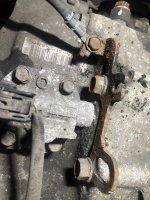I finally decided to removed the air box and look at the grounding points for the 2 skinny wires that Honda likes to use.
The skinny bolt attaches to cross brace in order to make better contact but not sure.
The whole thing is rusty and crusty green at the wires. This ground is at the trans, and the other skinny wire is at the fender (crusty green too).
How best to fix this darn thing:
1. Remove the whole wire brush if not clean install new cross plate.
2. Delete cross plate add an additional wire to other bolt straight to battery.
3. Delete skinny wires, install one much thicker wires at trans and fender.
The skinny bolt attaches to cross brace in order to make better contact but not sure.
The whole thing is rusty and crusty green at the wires. This ground is at the trans, and the other skinny wire is at the fender (crusty green too).
How best to fix this darn thing:
1. Remove the whole wire brush if not clean install new cross plate.
2. Delete cross plate add an additional wire to other bolt straight to battery.
3. Delete skinny wires, install one much thicker wires at trans and fender.

